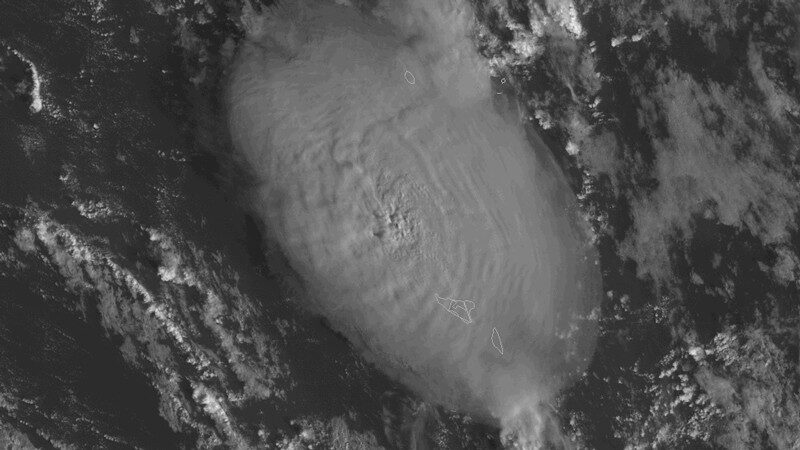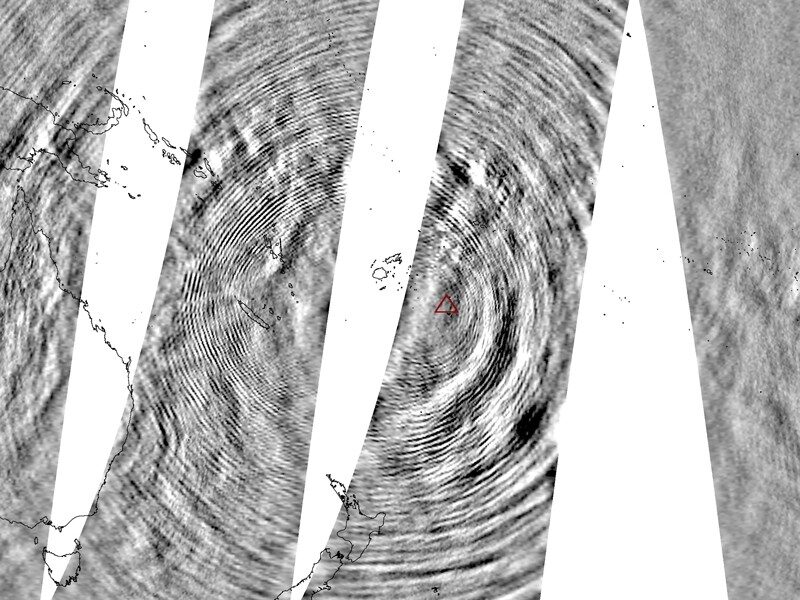Comment: We're through the looking glass here people!
Powerful waves ringing through the atmosphere after the eruption of Hunga Tonga-Hunga Haʻapai are unlike anything seen before.

"It's really unique. We have never seen anything like this in the data before," says Lars Hoffmann, an atmospheric scientist at the Jülich Supercomputing Centre in Germany.
The discovery was made in images collected by the Atmospheric Infrared Sounder (AIRS), mounted on Nasa's Aqua satellite, in the hours after the eruption of the Hunga Tonga-Hunga Haʻapai volcano on 14 January.
They show dozens of concentric circles, each representing a fast-moving wave in the gases of the atmosphere, stretching for more than 16,000 kilometres. The waves reached from the ocean surface to the ionosphere, and researchers think that they probably passed around the globe several times.
'Nice concentric wave patterns'
"This instrument has been operating for something like 20 years now and we have never seen such nice concentric wave patterns," Hoffmann adds.
Atmospheric gravity waves occur when air molecules in the atmosphere are vertically, rather than horizontally, disturbed in the air column. This can happen as wind picks up speed as it rises over a mountaintop, or as a result of convection in local weather systems.
The up-and-down waves transfer energy and momentum through the atmosphere, and often show their effects in the way in which they cause high clouds to form in a series of ripples.

"That's what's really puzzling us," says Corwin Wright, an atmospheric physicist at the University of Bath, UK. "It must have something to do with the physics of what's going on, but we don't know what yet."
He and his co-workers suspect that a "great big, messy pile of hot gases" in the upper atmosphere might be what kicks the waves off. The hot gas is "going up high into the stratosphere and knocking the air around", he says.
Comment: Or, the atmosphere's composition has fundamentally altered - electro-chemically - in recent decades, producing 'novel effects'. See 'chemtrails', for example, which are mostly jet contrails lingering longer in the atmosphere than they used to.
Eruption heard across the planet
The eruption of the Hunga Tonga-Hunga Haʻapai volcano was heard across the South Pacific, and even in parts of the United States. Ash has covered many regions of Tonga, but a loss of power, phone lines and Internet connectivity has made it difficult for aid agencies to assess the extent of injuries, fatalities and damage.
Wright, who was the first to spot the wave patterns in data supplied by Hoffmann, says that the images show what looks like a mixture of wave sizes and types.
The convection in the atmosphere seems to be "very complicated and bumpy, and it's generating a whole family of things at the same time", he says. "That is what we currently think is going on, but we've only been looking at it for a few hours."
The discovery was prompted by a tweet sent to Wright on 15 January from Scott Osprey, a climate scientist at the University of Oxford, UK, who asked: "Wow, I wonder how big the atmospheric gravity waves are from this eruption?!"
Explosive speed
Osprey says that the eruption might have been unique in causing these waves because it happened very quickly relative to other eruptions. "This event seems to have been over in minutes, but it was explosive and it's that impulse that is likely to kick off some strong gravity waves," he says.
The eruption might have lasted moments, but the impacts could be long-lasting. Gravity waves can interfere with a cyclical reversal of wind direction in the tropics, Osprey says, and this could affect weather patterns as far away as Europe. "We'll be looking very carefully at how that evolves," he says.
The imagery and data collected from the eruption has been "spectacular" and has presented scientists with an exciting opportunity, says Vicki Ferrini, a marine geophysicist at Columbia University in New York City. But she adds that she and others remain deeply concerned for the people of Tonga, particularly given the absence so far of detailed information on the scale of the disaster.
Researchers in New Zealand say that they are closely monitoring the volcano for further eruptions. "We are just keeping our ears to the ground," says Shane Cronin, a volcanologist at the University of Auckland. The volcano could be resupplied with large amounts of magma from deep underground and produce more explosive eruptions, he says. But if it has exhausted its main supply, it might produce only smaller eruptions, largely hidden beneath the surface of the ocean.



Reader Comments
These Air Force 'rods from God' could hit with the force of a ...[Link] › Articles
The cleverness of geoengineered weather and "catastrophes" is that no one can be blamed. You've created havoc and terror...but no one can trace the act to you. I think all the technologically advanced nations are employing in this tactic today...especially Israel. From an extremely good article on Lew Rockwell [Link] a few years ago:
It was said back in the days of Atlantis and Lemuria they had weather wars that destroyed each other so maybe this is going to be the second coming for a reset of earth, those dam lizards will do anything to get rid of us.
I could easily envision weather wars developing from such a wayward spirit. I have read, though, that Lemuria preceded Atlantis by several hundreds of years and that they overlapped only in the very early beginning of Atlantis. Some of the vestiges remained but not the Lemurian continent. I could be wrong because information is so sketchy.
Yes, the peculiar burns in parts of the world. The weirdest story I read was related by a Middle Easterner who testified that "a ray" boiled their ocean near his village and waves of cooked, dead fish floated ashore!
I think the Lizards are running the Covid Caper through their bloodlines (those at the highest levels on Earth have bloodlines which mix with off-planet forces--Luciferians) while the Tall Greys or Dracos are geoengineering the planet and genetically altering humans.
Some history that was not totally vaporized between the 1700s and 19th century was the mud floods over the world a time when Tartara and most of its people disappeared, they were the twelve foot giants that built the beautiful cities around the world. The star forts, free electricity from the ether, elect cars, scooters. Many of these building are here today only the elite falsified our history and tried to destroy everything that was, when enough people find out about this I think they will be very pissed off for being deceived. Nikola Tesla was bring back that Tec. that was destroyed from the past for the good of humanity and then the elite put a stop to it.
Many years ago around 20I1 read an article from a man in Iraq that I believe he was traveling to Baghdad with his car and had three passengers in the back seat one up front and as he was driving a beam came down through the roof and sliced the people in back, cutting bodies in half, heads off and then moved forward slicing his right arm off and his front passengers body in half. There was no blood spilled but he drove to the hospital and no one could be saved except himself. The laser Tec. experiments from UFOs by the elite secret space force and Milab. This Tec. is being used for the death and destruction with the use of lasers starting fires burning around the world. I think with the intent of using this for a fake alien invasion at some point in time.
Your right about the Reptilians and Hybrid's of humans, cloning. There is a war going on way more than people are aware of, a spiritual war for this so call planet. The deep under ground basses and tunnels around the world are being blown up and most of the tunnels are at 10 km just as the earth quakes are too. Just look at earth quake map and see, there is also a reason for all the flooding of the water and dams breaking over the world. The under ground tunnels are being filled with water and distroyed after the children have been saved from there inhuman experiments, lots going on and people need to wake up so we can move on to another higher reset of consciousness.
I believe in the near future all will be brought to light. We all want truth at some point in our lives and some not.
When I had my reading with one of her associates whom she had trained, she came to me and asked me, please, if I would tell her associate how proud she was of her. Weird!!! She didn't make a "grand entrance." I simply knew who she was immediately while the information was imparted simultaneously. I received the impression that "we" are here all the time whether or not present in physicality.
I read a very devastating story about these EM weapons. Middle Eastern villagers who saw a small car with inhabitants beamed and reduced to the size of a microwave oven. The U.S. military later came and scooped up/buried the box.
Nicolay, the psychic I read, has been told that the Earth will have a Eurasian Enlightenment. Germany, Eastern Europe, and Russia will become the areas of intense development of knowledge in all spheres and realms. Supposedly, the level of this civilization (after a nuclear holocaust in the ME) will the highest ever attained on this planet. I suppose this declaration includes Atlantis.
I believe, too, that much history has been lost. In some cases, an elite group may have hidden history. I think, too, that history simply disappears, and when archeologists dig up some evidence, they completely misinterpret the time, culture, and artifact. I think we all wondered, as we encountered history classes in school, what the hell happened to all those people when a "new" dominant country suddenly appeared. What happened in all those missing years? I didn't become overly suspicious...I just never really believed them after that point.